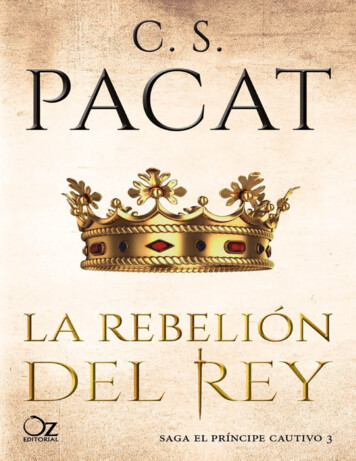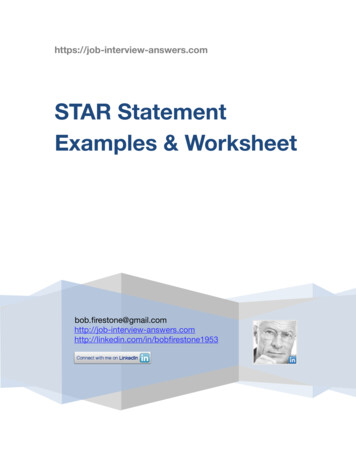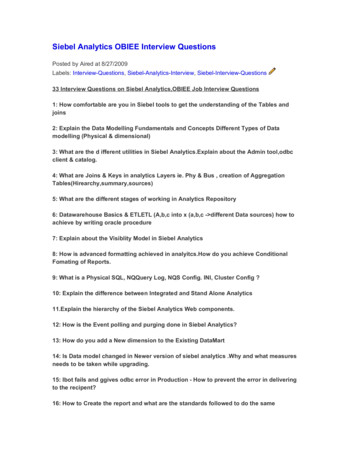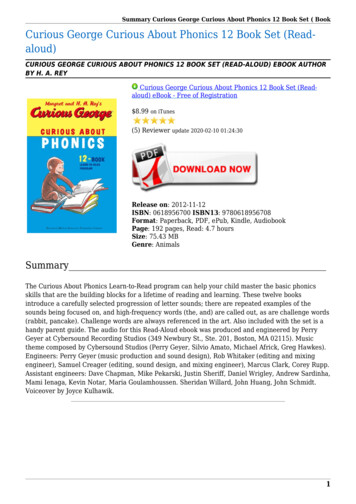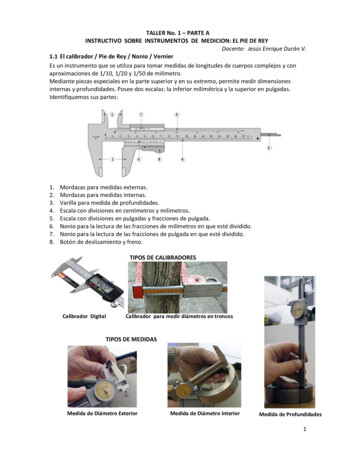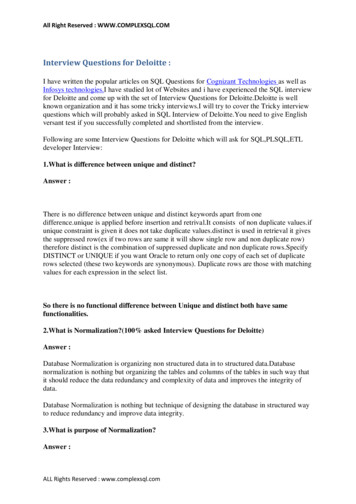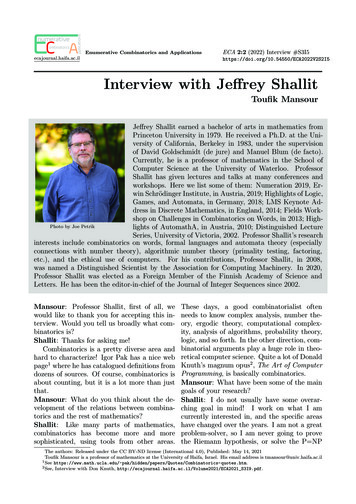
Transcription
pplicationsnumerativeAombinatoricsEnumerative Combinatorics and Applicationsecajournal.haifa.ac.ilECA 2:2 (2022) Interview ew with Jeffrey ShallitToufik MansourJeffrey Shallit earned a bachelor of arts in mathematics fromPrinceton University in 1979. He received a Ph.D. at the University of California, Berkeley in 1983, under the supervisionof David Goldschmidt (de jure) and Manuel Blum (de facto).Currently, he is a professor of mathematics in the School ofComputer Science at the University of Waterloo. ProfessorShallit has given lectures and talks at many conferences andworkshops. Here we list some of them: Numeration 2019, Erwin Schrödinger Institute, in Austria, 2019; Highlights of Logic,Games, and Automata, in Germany, 2018; LMS Keynote Address in Discrete Mathematics, in England, 2014; Fields Workshop on Challenges in Combinatorics on Words, in 2013; HighPhoto by Joe Petriklights of AutomathA, in Austria, 2010; Distinguished LectureSeries, University of Victoria, 2002. Professor Shallit’s researchinterests include combinatorics on words, formal languages and automata theory (especiallyconnections with number theory), algorithmic number theory (primality testing, factoring,etc.), and the ethical use of computers. For his contributions, Professor Shallit, in 2008,was named a Distinguished Scientist by the Association for Computing Machinery. In 2020,Professor Shallit was elected as a Foreign Member of the Finnish Academy of Science andLetters. He has been the editor-in-chief of the Journal of Integer Sequences since 2002.Mansour: Professor Shallit, first of all, wewould like to thank you for accepting this interview. Would you tell us broadly what combinatorics is?Shallit: Thanks for asking me!Combinatorics is a pretty diverse area andhard to characterize! Igor Pak has a nice webpage1 where he has catalogued definitions fromdozens of sources. Of course, combinatorics isabout counting, but it is a lot more than justthat.Mansour: What do you think about the development of the relations between combinatorics and the rest of mathematics?Shallit: Like many parts of mathematics,combinatorics has become more and moresophisticated, using tools from other areas.These days, a good combinatorialist oftenneeds to know complex analysis, number theory, ergodic theory, computational complexity, analysis of algorithms, probability theory,logic, and so forth. In the other direction, combinatorial arguments play a huge role in theoretical computer science. Quite a lot of DonaldKnuth’s magnum opus2 , The Art of ComputerProgramming, is basically combinatorics.Mansour: What have been some of the maingoals of your research?Shallit: I do not usually have some overarching goal in mind! I work on what I amcurrently interested in, and the specific areashave changed over the years. I am not a greatproblem-solver, so I am never going to provethe Riemann hypothesis, or solve the P NPThe authors: Released under the CC BY-ND license (International 4.0), Published: May 14, 2021Toufik Mansour is a professor of mathematics at the University of Haifa, Israel. His email address is tmansour@univ.haifa.ac.il1 See https://www.math.ucla.edu/ pak/hidden/papers/Quotes/Combinatorics-quotes.htm. 2 See, Interview with Don Knuth, http://ecajournal.haifa.ac.il/Volume2021/ECA2021 S3I9.pdf.
Interview with Jeffrey Shallitquestion3 . Instead, I enjoy finding interesting and unexpected connections between different parts of mathematics, especially witha discrete or computational flavor. Lately, Ihave been very interested in combinatorics onwords, where a lot can be proved or disproved“automatically” using a logical decision procedure.Mansour: We would like to ask you aboutyour formative years. What were your earlyexperiences with mathematics? Did that happen under the influence of your family or someother people?Shallit: My parents were very supportive ofmy interest in mathematics and science. I wasalso very lucky to have had several excellentmentors. Some that particularly stand out are: William Davidon, a professor of physics atHaverford College outside Philadelphia,suggested to my father some mathematicsbooks to read. (Davidon, by the way, wasalso the covert mastermind of the 1971break-in at an FBI office that disclosedthe COINTELPRO surveillance.) myjunior-high-schoolmathematicsteacher Robert Stauffer, who conveyedthe excitement and breadth of mathematics and told our class over and over, “Youcan get a Pee-Aitch-Dee in this stuff!” Neil Sloane, who encouraged me to contribute to his Encyclopedia of Integer Sequences. The staff at the IBM Scientific Center inPhiladelphia, including Kenneth Iverson,Eugene McDonnell, and Don Orth, whoallowed me the opportunity to work during the summer of 1973, where I learnedthe computer language APL.Mansour: Were there specific problems thatmade you first interested in combinatorics?Shallit: I can mention a few things. I(re-)discovered the Bell numbers Bn 4 at age 15,and then tried to find out more about them. Itried to read early journal papers about them,but it was a mysterious and almost impenetra3 Forble world: nobody I knew could explain to mewhat the umbral calculus was!A second problem was mentioned to me byJohn Hughes in 1980: can one construct aninfinite sequence over a ternary alphabet containing no two consecutive identical blocks? Atthe time I did not know this was a classic problem in combinatorics on words originally due toAxel Thue5 in 1906.I discovered the two beautiful French booksof Louis Comtet6 on combinatorics when Iwas an undergraduate, and these certainly increased my interest in the subject. (“Comtet”,which sounds like the French word for the verb“to count”, is an almost-optimal name for acombinatorialist.)Mansour: What was the reason you chosethe University of California, Berkeley, for yourPh.D. and your advisor Manuel Blum?Shallit: I wanted to be at a place thathad a good number theory program, a goodcomputer science program, and free access tothe computer language APL. I narrowed mytop choices down to two: Berkeley and Massachusetts Institute of Technology (MIT). Butunfortunately, MIT lost part of my application,and I was never even considered by them. SoBerkeley it was. It turned out to be a greatchoice for me.When I arrived at Berkeley in 1979, I immediately went to see D. H. Lehmer, hopinghe would agree to be my thesis supervisor incomputational number theory. I had not realized that he was 74 years old and no longertaking students, so after he refused, I had tocast around for a different supervisor. ManuelBlum, in the computer science department,was working on computational problems withnumber theory aspects, so it was natural that Ibegan to work with his group, which includedinteresting and creative people like Eric Bachand Shafi Goldwasser.Mansour: What was the problem you workedon in your thesis?Shallit: I worked on several problems atBerkeley, but the problem that eventually became my thesis was the analysis of a very sim-?example, see S. Aaronson, P NP, in Open problems in mathematics, Springer, Cham, 2016, 1–122.https://oeis.org/A000110.5 A. Thue, Über unendliche Zeichenreichen, Norske Vid Selsk. Skr. I. Mat. Nat. Kl. Christiana 7 (1906), 1–22.6 L. Comtet, Analyse combinatoire, Tomes I, II. (French) Collection SUP: “Le Mathématicien”, 4, 5 Presses Universitaires deFrance, Paris, 1970.4 SeeECA 2:2 (2022) Interview #S3I52
Interview with Jeffrey Shallitple algorithm called the Pierce expansion7,8 :start with a real number x x0 between 0and 1 and repeatedly set xn 1 1 mod xn .If x p/q, a rational number, how manysteps are needed to reach 0? And if x is irrational, what is the expected size of xn ? Itturns out that the second question is much easier to answer than the first one: it is about e n .The first question is still not completely understood, and I offer a cash prize9 for improvingthe best results currently known.Mansour: What guides you in your research?A general theoretical question or a specificproblem?Shallit: I have always been more interestedin specific problems. But sometimes a specificproblem might suggest a much bigger underlying theory. One example in my own work isthe concept of k-regular sequence10 , which unifies a large number of classical sequences underone framework.Mansour: When you are working on a problem, do you feel that something is true evenbefore you have the proof?Shallit: Psychologically, it seems that usually,you have to firmly believe something is true before you can find the proof. If you have significant doubts, somehow you are less motivated.For me, conducting numerical experiments often helps me figure out what the true story is.Mansour: What are the top three open questions in your list?Shallit: In addition to the problem aboutPierce expansions mentioned previously, theones that appeal to me personally are the following: How many binary strings of length 2n canbe obtained by taking any binary string xof length n, and “shuffling” it with itself?Here I am not talking about “perfect shuffle”11 , but any left-to-right interleaving ofx with itself. Nobody knows an efficientway to compute this, or even good asymptotic bounds. It is sequence A191755 inthe On-Line Encyclopedia of Integer Se-quences (OEIS12 ). How many states are necessary and sufficient, in the worst-case, for a deterministic finite automaton to distinguish between two length-n binary strings (thatis, accept one but not the other)? Examples where Ω(log n) states are neededare known, and the best upper bound currently known is rough O(n1/3 ), due toZachary Chase13 . But these bounds arewidely separated.Mansour: What kind of mathematics wouldyou like to see in the next ten-to-twenty yearsas the continuation of your work?Shallit: As I mentioned above, I have beenworking on what parts of combinatorics onwords can be proved “automatically” using adecision procedure, with basically no humanintervention, and I would be pleased to seeother results along these lines. One of yourprevious interviewees, Doron Zeilberger14 hasbeen doing this for enumerative combinatoricsfor years and is a real pioneer in this area.Mansour: Do you think that there are core ormainstream areas in mathematics? Are sometopics more important than others?Shallit: What’s considered “core” or “mainstream” or “important” changes throughouttime. The classical invariant theory was actively studied in the late 1800s, but then it almost completely vanished, and now it has beenresurrected again. When I was a graduate student, it seemed everyone in theoretical computer science was working on very large scaleintegration (VLSI) layout problems, but nowthe interest in theoretical aspects of VLSI hasdisappeared.Discrete mathematics, including combinatorics, is becoming more and more viewed asa core area, in part because of its role in computer science and biology.Mansour: What do you think about the distinction between pure and applied mathematics that some people focus on? Is it meaningful at all in your case? How do you see the7 J.Shallit, Metric theory of Pierce expansions, Fibonacci Quart. 24 (1986), 22–40.Erdős and J. Shallit, New bounds on the length of finite Pierce and Engel series, Sém. Théor. Nombres Bordeaux (2) 3:1(1991), 43—53.9 See g-known-bounds-for-pierce-expansions-cash-prize.10 J.-P. Allouche and J. Shallit, The ring of k-regular sequences, Theoret. Comput. Sci. 98 (1992), 163–197.11 P. Diaconis, R. L. Graham, and W. M. Kantor, The mathematics of perfect shuffles, Adv. in Appl. Math. 4 (1983), 175–19612 See https://oeis.org/.13 Z. Chase, A new upper bound for separating words, arXiv:2007.12097v2, 2020.14 Interview with Doron Zeilberger, http://ecajournal.haifa.ac.il/Volume2021/ECA2021 S3I3.pdf.8 P.ECA 2:2 (2022) Interview #S3I53
Interview with Jeffrey Shallitrelationship between so-called “pure” and “applied” mathematics?Shallit: Applications have never been that interesting to me. I am more motivated by theintrinsic beauty of a question, its relationshipto other areas of mathematics and computerscience, and the degree to which answers ormethods are surprising. But if there are applications, too, so much the better!Mansour: What advice would you give toyoung people thinking about pursuing a research career in mathematics?Shallit: Read as much as you can, in as manydifferent areas as you can. Browse the Princeton Companion to Mathematics15 . Get involved in undergraduate research through programs such as the NSF REU program in theUS, and the NSERC USRA in Canada. Readthe problem section of the American Mathematical Monthly every month, and try to solvethe problems. Avoid time-wasters like socialmedia. Find people who know more than youdo, and befriend them.Mansour: Would you tell us about your interests besides mathematics?Shallit: I have a rather random set of interests, including mineralogy, numismatics, escape literature (that is, books about escapesfrom prisoner-of-war camps), eclipses, familygenealogy, mystery novels, history, linguisticsand foreign languages, evolutionary biology,the desert Southwest, natural history, moose,baseball, birds, and guitar music. The historyof ideas and the origins of things particularlyinterest me. Lately, I have been reading a series of books by Ian Mortimer about Englishhistory, and I have been enjoying them verymuch.Mansour: Before we close this interview, wewould like to ask you some more specific questions. In your blog Recursivity16 you describedyourself as an American mathematician, professor of computer science at a major Canadian university, and skeptic. Would you uncover for our readers the term “skeptic”?Shallit: For me, a “skeptic” is somebodywho thinks that “it is undesirable to believea proposition when there is no ground whatever for supposing it true” (Bertrand Russell).So a skeptic typically doubts the existence ofsupernatural beings, Bigfoot and extraterrestrial aliens visiting the Earth, and is not likelyto subscribe to preposterous conspiracy theories such as “9-11 Truth” or “the Plandemic”.Of course, a skeptic should always be willingto re-examine their beliefs in light of new evidence. But “extraordinary claims require extraordinary evidence”.Mansour: You have contributed to the wellknown online mathematical forum Mathoverflow. How did you decide to join it? What doyou think about this kind of discussion forum?Shallit: I cannot remember. Probably somecolleague told me about it. Anything thatbrings people who are interested in mathematics together is a good idea.Mansour:In one of your major results Polynomial versus exponential growth inrepetition-free binary words17 , co-authored byJ. Karhumäki, you solved an open problemproposed by Kobayashi18 , and answered thequestion ‘For what value of exponent α doesthe number of binary words avoiding α-powersswitches from polynomial growth to exponential one?’ You showed that ‘the dividing line’between polynomial and exponential growth is7. Would you briefly tell us about this prob3lem and why this fraction appears? Are theresimilar problems and results in your field ofresearch?Shallit: That was a very fun problem aboutrepetitions in words! To explain it, I need thenotion of period and exponent of a word. Aperiod of a word w is a positive integer p suchthat w[i] w[i p] for all meaningful indices i.For example, the word alfalfa has a period 3:each symbol equals the symbol appearing threepositions earlier. The exponent of a word is itslength divided by its shortest period. So theexponent of alfalfa is 7/3.If a word contains no block whose exponentis larger than α, we say it is α -free. Thue19proved that there are infinitely long words thatare 2 -free. One can also count the number of15 T.Gowers et al., editors, The Princeton Companion to Mathematics, Princeton University Press, 2008.http://recursed.blogspot.com.17 J. Karhumäki and J. Shallit, Polynomial versus exponential growth in repetition-free binary words, J. Combin. Theory Ser.A 105:2 (2005), 335–347.18 Y. Kobayashi, Repetition-free words, Theoret. Comput. Sci. 44 (1986), 175–197, Problem 6.6.19 A. Thue, Über unendliche Zeichenreihen, Norske vid. Selsk. Skr. Mat. Nat. Kl. 7 (1906), 1–22 (Reprinted in: T. Nagell(Ed.), Selected Mathematical Papers of Axel Thue, Universitetsforlaget, Oslo, 1977, 139–158).16 SeeECA 2:2 (2022) Interview #S3I54
Interview with Jeffrey Shallit2 -free binary words of length n, and it turnsout that there are only polynomially many20 .On the other hand, there are exponentiallymany 3 -free binary words of length n. Thissuggests that there might be some exponent αwhere the growth rate of α -free binary wordsabruptly changes from polynomial to exponential, and it turns out that the switchover pointexists and is exactly 7/3.This is just one in a long line of similarresults about the avoidability of patterns inwords. There are dozens and dozens of paperson the topic.Mansour: In your joint paper, Folded continued fractions21 , co-authored with well-knownnumber theorist Alf van der Poorten, youmake some interesting connections betweensome binary sequences, continued fractions,and paper-folding sequences. Would you tellus about this work?Shallit: I cannot possibly improve on my coauthor’s beautiful article FOLDS!22 , which appeared in three parts in the Mathematical Intelligencer in 1982. So I’ll just direct readers tothat amazing piece of work, written by MichelDekking, Michel Mendès France, and Alf22 .Mansour: The continued fraction expansions[a0 ; a1 , a2 , . . .] a0 1/(a1 1/(a2 . . .)) forwhich the sequence (ai ) is bounded appear inmany different fields of mathematics and computer science. You wrote a survey paper23 onthis topic in 1992. Would you tell us aboutsome current research activities on this topicand point out some future research directions?Shallit: Numbers with bounded partial quotients are also called badly approximable, andarise in many different areas of mathematics,including Diophantine approximation, transcendental number theory, and numerical analysis. This class includes all the quadratic irrationals,as well as other numbers such asP 2nfor integers k 2. Zaremba’s conn 0 kjecture is probably the most interesting openproblem in the area: it says that for every positive integer denominator d, there is an integernumerator n such that the partial quotientsin the continued fraction for n/d are boundedby 5. There has been some recent very deepwork on this problem, by Bourgain and Kontorovich24 (just to mention two names), but itis still unsolved.Mansour: In one of your recent interestingjoint works, Critical exponents of infinite balanced words25 , you construct infinite balancedwords over an alphabet of different sizes andsome interesting numbers appear as critical exponents. Would you tell us about this researchand the motivation behind it?Shallit: Here we are back to words avoidingblocks of a given exponent. The critical exponent of an infinite word w is defined to bethe infimum over all α for which w is α -free;it is a measure of the repetitivity of the word.Dejean’s conjecture26 (now a theorem, provedby Currie & Rampersad27 , and Rao28 , independently) specifies the so-called “repetitionthreshold”: the smallest critical exponent onecan possibly achieve, considering all words overan alphabet of size k. But it is also interestingto compute this repetition threshold for otherclasses of words. One interesting class is theso-called balanced words, where every length-nblock has approximately the same distributionof letters as every other length-n block. Together with my co-authors Narad Rampersad,Élise Vandomme25 , and Aseem Baranwal29 , wefound the repetition threshold for a number ofdifferent alphabet sizes. An interesting featureof our work is that some of the results wereproved using a decision procedure where it wasjust necessary to state the desired result as afirst-order logical statement, and sit back andwait for the prover to prove it.Mansour: Let us briefly discuss your book,co-authored with J.-P. Allouche, AutomaticSequences: Theory, Applications, Generaliza-20 Seehttps://oeis.org/A007777van der Poorten, J. Shallit, Folded continued fractions, J. Number Theory 40:2 (1992), 237–250.22 M. Dekking, M. M. France, and A. van der Poorten, A. Folds, Math. Intelligencer 4 (1982), 173–181.23 J. Shallit, Real numbers with bounded partial quotients, Enseignement Math. 38 (1992), 151–187.24 For example, see J. Bourgain and A. Kontorovich, On Zaremba’s conjecture, Ann. of Math. 180:1 (2014), 137–196.25 N. Rampersad, J. Shallit, and É. Vandomme, Critical exponents of infinite balanced words, Theoret. Comput. Sci. 777 (2019),454–463.26 F. Dejean, Sur un théorème de Thue, J. Combin. Theory, Ser. A 13 (1972), 90–99.27 J. Currie and N. Rampersad, A proof of Dejean’s conjecture, Mathematics of Computation 80 (274) (2011), 1063–1070.28 M. Rao, Last cases of Dejean’s conjecture, Theoret. Comput. Sci. 412 (2011), 3010–3018.29 A. R. Baranwal and J. Shallit, Repetitions in infinite palindrome-rich words, In R. Mercas and D. Reidenbach (eds.) Combinatorics on Words, WORDS 2019, Lecture Notes in Computer Science, Volume 11682, Springer, 2019, 93–105.30 J.-P. Allouche and J. Shallit, Automatic Sequences: Theory, Applications, Generalizations, Cambridge University Press, 2003.21 A.ECA 2:2 (2022) Interview #S3I55
Interview with Jeffrey Shallittions30 . It is a great source for sequences generated by finite automata, their generalizations,and applications to number theory and theoretical physics. Are you ‘optimistic’ aboutother new connections and applications finiteautomata may appear in? Do you plan to expand it in the new edition? Or maybe you willwrite another book?Shallit: Someday we will write a new edition of Automatic Sequences, if there is “worldenough, and time”. In the meantime I amworking on a book manuscript where we discuss the interaction between automatic sequences and logic, using a theorem-provercalled Walnut created by my former studentHamoon Mousavi31 .Mansour: Your paper What this countryneeds is an 18-cent piece32 , published in Math.Intelligencer in 2003, generated a lot of mediaand bloggers’ attention, including Forbes magazine. What was the main point of the paper?Did you expect so much media attention?Shallit: The motivation originally arose fromtrying to find interesting problems for an undergraduate course on algorithm design. Acommon exercise in that course is to show thatfor the existing system of American coin denominations (1 , 5 , 10 , 25 ), the greedy algorithm gives the smallest number of coins forany desired amount of change from one centto 99 cents. This naturally suggests the question of choosing the denominations optimally,to get the smallest average number of coinsneeded to make the change. It turns out that ifwe do not restrict ourselves to using the greedyalgorithm, then the best choice of denominations is (1 , 5 , 18 , 25 ). So we should replaceour dime with an 18-cent piece!This led to my paper in the Intelligencer,which was intended to be tongue-in-cheek, butnot everybody had realized this. The bestoutcome was that my work was featured onNational Public Radio’s quiz show in the US,Wait Wait. Don’t Tell Me!, which has to beone of the highlights of my research career.Mansour: In a 1987 article of the New YorkTimes, they write “Without quite meaning to,Neil J. A. Sloane has become the world’s clear-inghouse for number sequences.” What do youthink about OEIS12 and its future? Whatare your favorite integer sequences from thedatabase?Shallit: The OEIS is an incredibly useful resource, and we should all be immensely grateful to Neil Sloane for creating it. I’ve contributed about 500 sequences to it, which isjust a drop in the bucket. I have many favorite sequences, but I will just mention one:A22095033 , the number of distinct languagesrecognized by unary nondeterministic finite automata with n states. Only five terms are currently known.Mansour: Would you tell us about yourthought process for the proof of one of yourfavorite results? How did you become interested in that problem? How long did it takeyou to figure out a proof? Did you have a “eureka moment”?Shallit: As a teenager I discovered continuedfractions through the marvelous little book ofC. D. Olds34 . And so I began to expand various real numbers as continued fractions, to seeif I could discover any interesting ones. Atfirst, I just used a Texas Instruments calculator, but eventually, I was able to compute themwith a digital computer. Mostly, I just rediscovered known results, such as the expansionof the numbers e2/n for odd positiveP integersnn. But then I tried the numbers n 0 k 2 .My experiments suggested these numbers havebounded partial quotients, but I could notprove it. As a freshman at Princeton, I foundthe analysis class so boring—I was never anygood at analysis—that I spent most of the classtime trying to construct a proof, and eventually succeeded. I would say it took me a yearor so, off and on (and I didn’t do so well inthat course). This paper35 was published inthe Journal of Number Theory in 1979, aftersome very long delays that are another story.Mansour: Is there a specific problem youhave been working on for many years? Whatprogress have you made?Shallit: Tom Brown (and later Pirillo & Varricchio and Halbeisen & Hungerbühler) askedif an infinite sequence exists over a finite subset31 Seehttps://arxiv.org/abs/1603.06017.Shallit, What this country needs is an 18-cent piece, Math. Intelligencer 25 (2003), 20–23.33 See https://oeis.org/A220950.34 C. D. Olds, Continued Fractions, Mathematical Association of America, 1963.35 J. Shallit, Simple continued fractions for some irrational numbers, Journal of Number Theory 11 (1979), 209–217.32 J.ECA 2:2 (2022) Interview #S3I56
Interview with Jeffrey Shallitof N, the natural numbers, containing no twoconsecutive blocks of the same size and samesum. This is a fascinating question; a heuristicargument by Pascal Ochem suggests the answer might be “no”, but there is still no proofone way or the other. I worked on it for a longtime, but could not solve it.Following the advice that “if you cannotsolve the original problem, change it to the oneyou can solve”, I started thinking about thesame problem with “two” replaced by “three”.In March 2011 I stumbled across the infiniteword 03143011 · · · , the fixed point of the mapsending 0 03, 1 43, 3 1, and 4 01,which seemed like a good candidate. But Icould not prove it had the desired property.Later on, I had a really brilliant master’sstudent, Luke Schaeffer, who saw how to applya technique of James Currie to the problem,and together with Julien Cassaigne, we wereable to prove that this construction actuallyworks. Our paper36 appeared in the Journalof the ACM in 2014. The moral of the story isthat it is great to have colleagues and studentsthat are smarter than you are.But the original problem for two blocks isstill—sadly!—unsolved.Mansour: Professor Jeffrey Shallit, I wouldlike to thank you for this very interesting interview on behalf of the journal EnumerativeCombinatorics and Applications.36 J. Cassaigne, J. D. Currie, L. Schaeffer, and J. Shallit, Avoiding three consecutive blocks of the same size and same sum, J.ACM 61 (2014), Paper 10.ECA 2:2 (2022) Interview #S3I57
Haverford College outside Philadelphia, suggested to my father some mathematics books to read. (Davidon, by the way, was also the covert mastermind of the 1971 break-in at an FBI o ce that disclosed the COINTELPRO surveillance.) my junior-high-school mathematics teacher Robert Stau er, who conveyed the excitement and breadth of mathemat-
